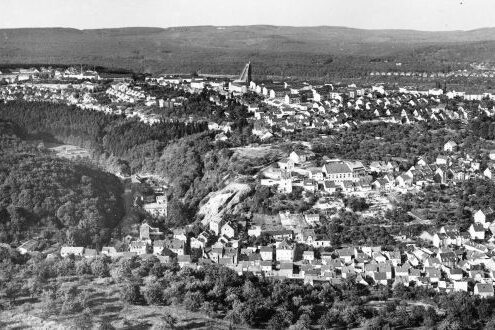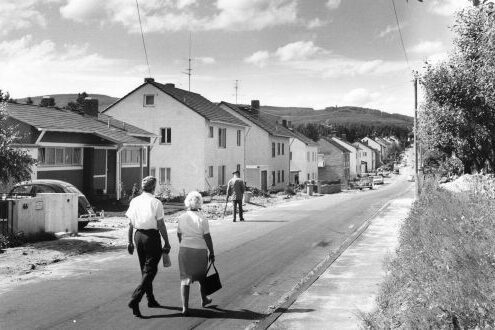Dotzheim
In the course of the planned Frankish settlement of our region, especially under King Dagobert I (623-638), a follower of the king probably settled in the valley of the Belzbach and gave the place its name - "Tuzzo", "Tuozo". Tuozesheim" eventually became Dotzheim.
The famous Dotzheim "fibula", a disc-shaped garment pin made of sheet bronze, which is now in the British Museum in London, dates from the early Franconian period (2nd half of the 7th century). Finds (pottery shards, weapons, axes and jewelry) prove that people were already living here in the Middle Neolithic and Bronze Age. The oldest evidence of settlement in the center of Dotzheim can be attributed to the "Latène period" (later Iron Age), which began around 400 BC and encompasses the heyday of the Celtic culture - up until the Roman invasion. At least five stone cist graves made of unhewn quartzite slabs were discovered in the area of Hohlstraße 3 in a very confined space. The Romans also left their mark: In the first year of the reign of Emperor Severus Alexander, i.e. in 222, Fortunatus and Sejus donated an altar, a fragment of which has been recovered.
The written tradition begins quite late in the 12th century. In 1128, the Archbishop of Mainz, Adalbert von Saarbrücken, left income from the Dotzheim properties of the archbishopric to the cathedral chapter there. Dotzheim is mentioned for the first time in this document ("dotzesheim"). On November 21, 1184 in Verona, Pope Lucius III (1181-1185) confirmed the possession of 25 churches, including the one in Dotzheim, to the Benedictine monastery of St. Alban in Mainz. The monastery appointed bailiffs to exercise monastic authority in Dotzheim.
From 1316, the Lords of Biegen exercised this office, in the 14th century the chamberlains of Worms, in the 15th century the von Scharfenstein and from 1526 the Brömser von Rüdesheim, who passed on their legal position to the Knights of Sickingen and the Barons of Metternich in 1668. The lords of St. Alban also appointed a mayor in their area of immunity. They had four court days held every year. In 1402, Pope Boniface IX incorporated the Dotzheim church completely into the monastery, which received all the income. The church service was to be conducted by monks or secular priests from the monastery. However, St. Alban was not able to maintain his rights in Dotzheim permanently, as in 1563 it was the Mainz cathedral chapter that ceded the right to occupy the parish as well as the parish goods and the parish tithe to Count Philipp II "Jungherr" zu Nassau-Idstein in return for an annual payment of 18 fl. In addition to the clergy of Mainz (cathedral chapter, St. Alban, Klara monastery, St. Johannis monastery, Karthäuser monastery), the monasteries of Eberbach and Klarenthal had estates in Dotzheim. In the 13th/14th century, several noble families called themselves "von Dotzheim".
The origins of Nassau rights in and over Doztheim are shrouded in mystery. It is possible that there was a court complex here which was connected to the royal court in Wiesbaden and passed to the Counts of Nassau at the end of the 12th century. High jurisdiction, which was still exercised by the Lords of Eppstein in the 13th century, also fell to the House of Nassau. In 1530, the bailiff of St. Alban's Monastery, Heinrich Brömser von Rüdesheim, recognized Count Philipp I "Altherr" zu Nassau as the holder of high jurisdiction.
The village court, first mentioned in 1386, can be considered the beginning of local self-government. It was responsible for civil matters and met under the chairmanship of the mayor, who was assisted by four aldermen. At the end of the 16th century, two mayors were in charge of the municipality's financial affairs. Other municipal offices included two shooters for the forest and fields, two church wardens and two shoemakers. There was a village blacksmith, a community baker and a shepherd paid by the community. In 1430, the village of Dotzheim was protected by fences and trap gates. In 1569, Johann Lonicerus became the first Protestant pastor. Dotzheim's modest village school was established around 1594. The court seal from 1636 shows the municipality's coat of arms, a large T accompanied by the letters C and K. No agreement has yet been reached on the interpretation of the T as the cross of St. Anthony, a tool or a reference to the oldest form of the name, Tozesheim. C and K refer to the mayor at the time, Christoph Kemel. In 1610, around 50% of the village's buildings were lost through arson.
However, the effects of the Thirty Years' War were more serious: in 1644, Dotzheim was practically uninhabited. The first inhabitants returned in 1645. In 1648, only 10 to 14 families lived in Dotzheim, whereas before the war there had been 72 households. It took decades to overcome the consequences of the war. In 1695, the parish had the stately rectory built opposite the church, followed by a schoolhouse in 1698. The new parish church was built in 1716/18 according to plans by the Nassau master builder Johann Jakob Bager. In the wake of the wars triggered by the French Revolution of 1789, Dotzheim was plundered in July 1796 and 500 soldiers set up camp here. The inhabitants had to supply the occupiers with food and wine, and the total damage caused by the occupation amounted to 10,850 fl. In 1819, around 900 inhabitants lived in Dotzheim.
At the beginning of the 19th century, two important clergymen worked in the village: Pastor August Ludwig Christian Heydenreich was one of the leading figures of the Nassau Union movement. Johann Christian Reinhard Luja initiated the founding of the Association for Nassau Antiquities and Historical Research in 1811 and secured prehistoric and Roman finds in the Dotzheim district. The small Dotzheim Jewish community, which had 37 members in 1843, produced Dr. Salomon Herxheimer, born in Dotzheim in 1801, a preacher and educator who was recognized far beyond Nassau.
In the 19th century, Dotzheim developed into a residential community in which numerous construction workers lived who earned their living in the neighboring cosmopolitan spa town: Bricklayers, whitewashers, roofers and carpenters were in demand as workers in the constantly growing neighboring town. The population grew to 2,000 people in 1866 and by the turn of the century, the population had risen to 4,342 due to a constant influx of new residents. In 1817, work began on straightening the road to Wiesbaden, followed by the expansion of the Wiesbadener Chaussee in 1834/35. More and more farmers gave up farming in the 19th century and became construction workers in the town.
The connection to the Aartalbahn ("Langenschwalbacher Bahn") in 1889 brought further prosperity: A flourishing industrial and commercial area developed around the station. Factories settled at the station: The Philippi machine factory opened in 1895, the Carl Bender I. wood and sheet metal processing factory in 1896 and the furniture factory of the Grand Ducal-Luxembourg purveyor to the court Adolph Dams with 150 workers in 1898. The Wiesbaden oil mill Philipp L. Fauth, which was founded around 1910, was also located here; it employed around 100 workers. Finally, the local industry at Dotzheim station included the tin foil capsule production facility of A. Flach and Georg Pfaff, which manufactured closures for champagne and wine bottles.
Under the energetic reign of the last three mayors, namely Georg Heil (1881-1901), August Rossel (1901-13) and Eduard Sporkhorst (1913-28), the municipality received a new town hall, three schools, the beautifully laid out forest cemetery and an exemplary alignment development plan, which even then placed agriculturally valuable parts of the district under protection. The local infrastructure was also significantly improved by the creation of a central water supply (1906), the introduction of gas and electricity (1902 and 1906 respectively) and the construction of a Wiesbaden-Dotzheim streetcar line (1906). The post office on the upper Wiesbadener Straße was established in 1901 (it was closed in 1997). In the same year, the "Dotzheimer Zeitung", published by Philipp Dembach, appeared for the first time and was discontinued in 1933. The Catholic church was consecrated in 1902.
Since the fall of the Socialist Law in 1890, the local working class developed a lively club life: on September 30, 1893, a workers' educational association was founded, in 1899 a workers' singing club was established, in 1903 the workers' cycling club "Vorwärts", in 1908 the free gymnastics club. Civic associations had already existed since the middle of the 19th century, such as the gymnastics club of 1848, the choral society of 1859 and the music association of 1848. The most important local event before the First World War was the 69th general meeting of the Nassau Trade Association, which took place in Dotzheim in 1913. 240 delegates took part and 70 local businesses presented their products. Shortly before the outbreak of the First World War, the village had a population of around 6,200. It was proudly referred to as the "largest village in the Nassau region".
The First World War, the subsequent French occupation, inflation and separatist unrest as well as a general economic crisis led to serious cutbacks. At times, 3,000 Frenchmen were stationed in Dotzheim, followed by Englishmen from 1926. The socio-political disputes became more intense, and the economic crisis with its burdens made integration into the neighborhood appear to be the last resort. Dotzheim was thus incorporated into Wiesbaden on April 1, 1928, exactly 800 years after it was first mentioned. The high proportion of left-wing parties in the democratic elections of the Weimar Republic earned the municipality the nickname "red Dotzem".
In the Reichstag elections of 1924, the KPD received 21.5% and the SPD 40.4%. After the incorporation, the proportion of Nazi supporters rose steadily. This was followed from 1933 by Nazi terror, the persecution of political dissidents and the merciless expulsion and murder of members of the Jewish community. The Jewish businesses - in 1928 there were five butchers' stores, three manufactories and a second-hand goods shop - were sold or closed. The local politicians and trade unionists August Hölzel (SPD) and Theodor Bach (KPD) succumbed to Nazi terror in Dachau concentration camp shortly before the end of the war. The rearmament efforts of the National Socialist regime had led to extensive barracks being built on Kohlheck and Freudenberg. The buildings in Dotzheim survived the subsequent Second World War relatively undamaged. In the air raids of February 1945, 36 inhabitants died, 33 buildings were completely destroyed and 625 buildings were partially destroyed.
The need to resettle numerous refugees and displaced persons, as well as the attraction of Wiesbaden as the state capital and administrative seat, led to large areas of the Dotzheim field area gradually becoming building land. The settlement of Freudenberg(Freudenberg estate) and Märchenland(Märchenland estate) had already begun in the 1930s. This was followed by the Kohlheck area. Finally, Dotzheim's most impressive "Trabant", the large Schelmengraben estate, was built. In contrast, the Sauerland residential area (for 4,000 residents) was not quite as large.
Dotzheim boasts the diverse cultural and sporting activities of a community that has been able to maintain its independence and identity despite decades of integration into the larger entity of the state capital of Wiesbaden.
Literature
Kopp, Klaus: The history of the Knights of Dotzheim. Traces of a 13th/14th century lower noble family from the Middle Rhine (Schriften des Heimat- und Geschichtsvereins Dotzheim e.V. 12), Wiesbaden-Dotzheim 1987.
Kopp, Klaus: Dotzheim. From a Franconian hamlet to the largest village in the Nassau region. A historical overview. Publication series of the Heimat- und Verschönerungsverein Dotzheim e.V., Wiesbaden 1998.

